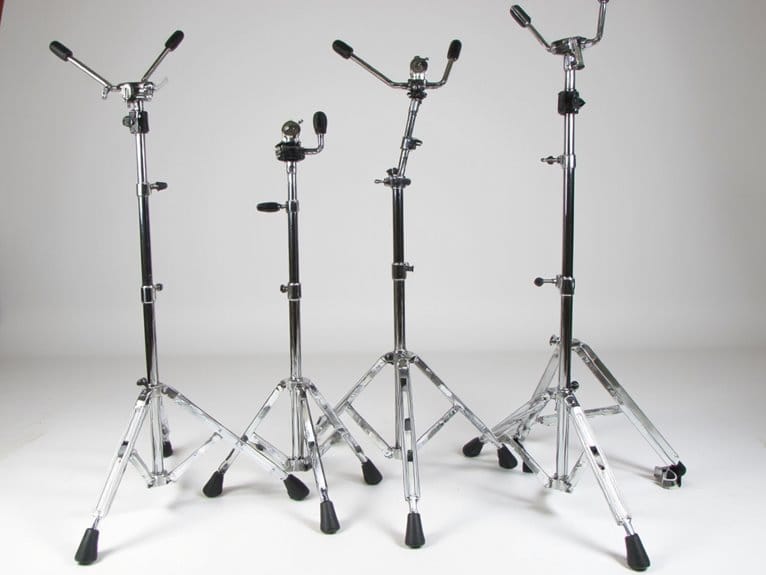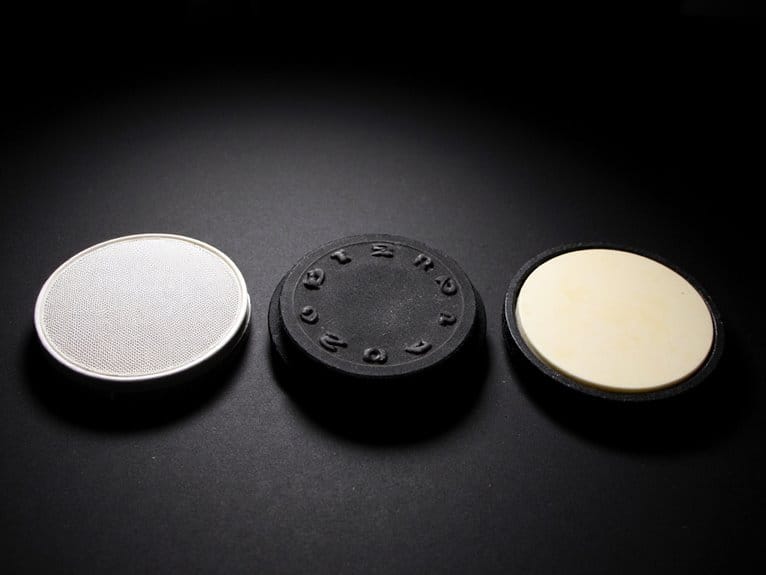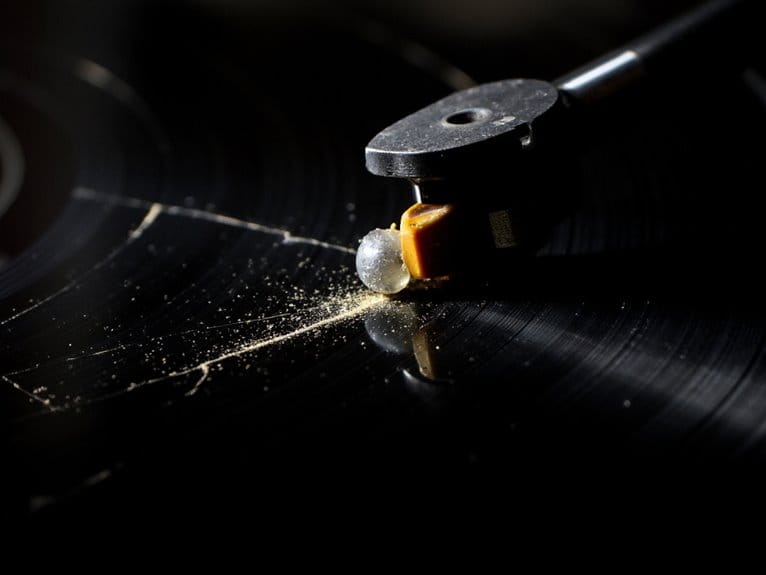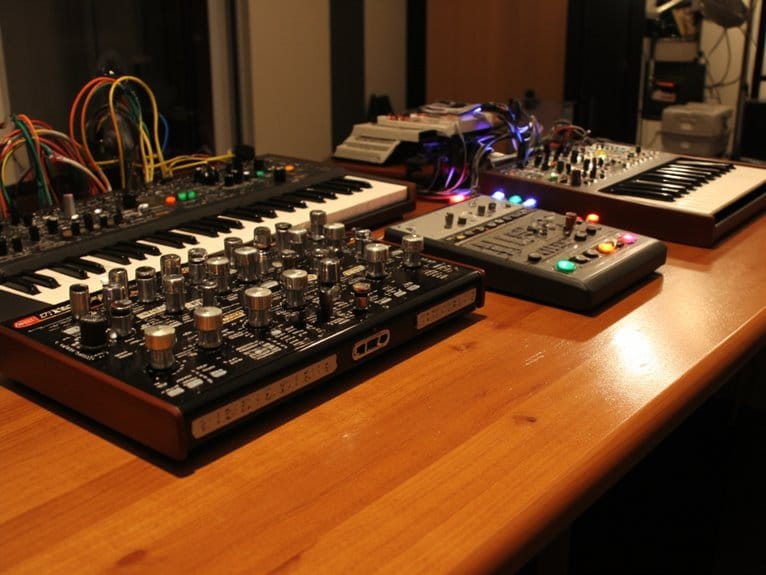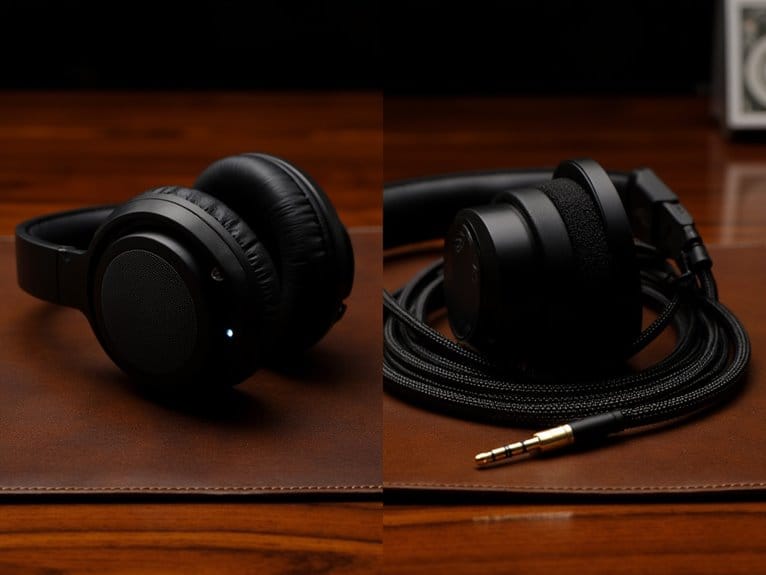Understanding Keyboard Sampling and Sound Customization
When you’re exploring keyboard sampling and sound customization, you’re fundamentally layering recorded audio samples across your keyboard’s keys, triggered by MIDI commands that respond to your playing dynamics and velocity. Modern workstations let you stack multiple samples, apply real-time effects like dynamic filtering and granular processing, and shape envelopes beyond basic ADSR parameters to create entirely new sonic textures from existing sounds. The journey from simple one-shot samples to complex multisampled instruments opens unprecedented creative possibilities.
We are supported by our audience. When you purchase through links on our site, we may earn an affiliate commission, at no extra cost for you. Learn more.
Notable Insights
- Keyboard sampling uses MIDI triggers and velocity layers to create realistic instrument emulation with dynamic responses to strike intensity.
- Sample layering combines multiple audio elements across frequency bands, using multiband compression and EQ to prevent muddiness and create balanced textures.
- Real-time effects processing transforms basic samples into expressive soundscapes through dynamic filtering, granular manipulation, and parameter control during performance.
- Professional multisampling libraries like Kontakt and UVI Falcon offer extensive format compatibility and sophisticated triggering features for enhanced sound quality.
- Modern sampling evolved from musique concrète to hip-hop, establishing sound manipulation as compositional material through specialized hardware and DAW software.
The Fundamentals of Audio Sampling and MIDI Triggering
When you’re diving into keyboard sampling, you’ll quickly discover that the magic lies in how digital audio samples respond to MIDI triggers, creating the foundation for everything from realistic piano emulations to cutting-edge electronic textures.
Understanding the distinction between one shot samples and looping techniques becomes essential as you craft your sound palette, with proper loop points determining whether your sustained notes flow naturally or sound choppy.
You’ll need to master velocity layers and dynamic layers, which respond to different strike intensities through MIDI channels, while maintaining trigger accuracy to avoid audio bleed between samples. The Audio Bend Tool provides precise transient detection that helps identify optimal trigger points for sample mapping.
Sample duration and note pitch work together to create authentic instrument behavior that responds precisely to your playing dynamics. The root key associated with each sample defines its playback pitch, with pitch changes occurring when other keys in the mapped range are pressed.
Advanced Sound Manipulation and Processing Techniques
Once you’ve mastered basic sampling fundamentals, you’ll discover that modern keyboard workstations offer sophisticated processing capabilities that transform simple recorded sounds into complex, evolving textures through real-time effects chains, multiple sample layers, and precise envelope controls.
I’ve found that combining these three techniques—real-time effect processing, creative sample layering, and dynamic envelope shaping—allows you to sculpt sounds that respond naturally to your playing dynamics while maintaining the organic character of the original samples. Implementing lock-free design strategies in your sampling system ensures smooth real-time performance without audio dropouts during intensive processing.
You can achieve everything from subtle atmospheric pads that breathe with your touch sensitivity to aggressive lead sounds that morph dramatically across the keyboard’s range, giving you unprecedented creative control over your sampled instruments. Modern synthesizers with MIDI connectivity enable seamless integration between your sampling workstation and external hardware, expanding your sound design possibilities exponentially.
Professional-grade audio interfaces featuring TotalMix FX software provide unlimited routing capabilities and real-time monitoring that ensure your sampled sounds maintain their pristine quality throughout the recording and performance process.
Just as bass players consider wattage flexibility when selecting practice amplifiers for different environments, keyboard players must evaluate their sampling workstation’s processing power to ensure optimal performance across various musical contexts.
Real-Time Effect Processing
The magic of real-time effect processing transforms ordinary keyboard samples into dynamic, evolving soundscapes that respond instantly to your musical gestures and creative intentions.
Through real time modulation, you’re manipulating parameters like filter cutoffs, delay times, and reverb depths while performing, creating expressive variations that breathe life into static samples.
Spectral analysis via FFT processing lets you surgically reshape frequency content, suppressing unwanted noise or crafting ethereal textures by targeting specific frequency bins.
Granular transformations break your samples into microscopic pieces, enabling time-stretching and pitch-shifting without traditional artifacts.
Dynamic filtering responds to your playing dynamics through envelope followers, automatically emphasizing or attenuating frequency bands based on how hard you strike the keys, resulting in naturally expressive performances that adapt to your touch.
Creative Sample Layering
Building on those real-time processing foundations, I’ve found that creative sample layering represents where keyboard sampling truly becomes an art form, allowing you to construct entirely new sonic identities by strategically combining multiple samples across carefully allocated frequency ranges.
Your layering techniques should assign distinct frequency bands to each sample, with sub-bass elements occupying 20-150 Hz for warmth, mid-frequency layers carrying body through distorted bass or plucked synths at 150-800 Hz, and high-frequency components providing brightness above 1 kHz.
Effective sound blending requires multiband compressors and surgical EQ to prevent muddiness while maintaining definition.
I particularly enjoy combining organic field recordings with synthetic elements, creating hybrid textures that transform predictable stock sounds into immersive, unique soundscapes through careful timing adjustments and envelope shaping.
Dynamic Envelope Shaping
Dynamic envelope shaping transforms static samples into living, breathing instruments that respond with the nuanced expressiveness of acoustic performances, moving far beyond basic ADSR adjustments to sculpt complex parameter movements that evolve throughout each note’s lifecycle.
| Parameter | Logarithmic Curve | Exponential Curve |
|---|---|---|
| Attack Feel | Smooth buildup | Sharp punch |
| Filter Sweep | Gentle opening | Dramatic snap |
| Pitch Bend | Natural glide | Aggressive dive |
| Amplitude Fade | Organic decay | Quick cutoff |
| Vibrato Amount | Gradual increase | Instant intensity |
Through envelope experimentation, you’ll discover that curve shapes dramatically alter your sample’s character—I’ve found logarithmic attacks create smoother brass sections while exponential curves deliver punchy percussion. Dynamic modulation across multiple parameters simultaneously creates evolving textures that breathe naturally, eliminating the mechanical feel that plagues many sample-based productions.
Multisampling Methods for Authentic Instrument Reproduction
When you’re building multisampled instruments, recording each note independently offers you the most authentic reproduction possible, capturing every subtle timbral shift and harmonic complexity that makes real instruments sound alive.
You’ll find yourself weighing professional multisampling libraries against custom recordings, since commercial options like Native Instruments Kontakt libraries provide immediate access to expertly crafted samples, while your own recordings offer unique character but demand significant time investment.
The storage versus authenticity trade-off becomes critical as you balance disk space limitations against sample density, because while recording every semitone with multiple velocity layers creates massive file sizes, the resulting realism often justifies the storage cost for professional applications.
Independent Note Recording Benefits
Since each note you’ll hear from a quality sampled instrument represents an individual recording session, the authenticity you’re getting isn’t just impressive—it’s fundamentally different from what happens when manufacturers take shortcuts.
These independent note advantages preserve unique tonal character that pitch-shifting simply can’t replicate, capturing every string resonance, hammer noise, and sympathetic vibration that makes instruments feel alive.
Here’s what you’re actually getting with independent note recording:
- Natural velocity responses – Each key responds to your touch with authentic dynamic variations
- Preserved harmonic complexity – Low and high registers maintain their distinct tonal personalities
- Eliminated digital artifacts – No “chipmunk effect” from stretching samples across multiple keys
- Enhanced expressiveness – Smooth crescendos and decrescendos that mirror real instrument behavior
Professional Multisampling Library Options
Several professional multisampling platforms have emerged as powerhouses in the authentic instrument reproduction field, each offering distinct approaches to capturing and recreating the nuanced behavior of real instruments.
Native Instruments Kontakt leads the pack with extensive third-party format compatibility, while MOTU MachFive 3 excels at authentic reproduction through deep multisampling techniques.
UVI Falcon focuses on flexible sound design with layered sampling approaches, and Ableton Live’s Sampler supports multiple formats including EXS and Kontakt for enhanced sound quality.
Magix Independence Pro includes over 70GB of premium content with sophisticated triggering features.
You’ll find these platforms utilize velocity switching, round-robin sampling, and crossfading to eliminate machine-gun effects while providing seamless shifts across dynamic ranges. Professional samplers typically require 24-bit/192 kHz audio resolution from quality interfaces to capture the full dynamic range and detail necessary for authentic instrument reproduction.
Similar to how budget audio interfaces achieve professional sound quality under $200, these multisampling platforms prove that accessible technology can deliver studio-grade results. Many modern samplers also feature zero-latency monitoring capabilities that enable real-time feedback during the sampling and playback process.
Storage Vs Authenticity Trade-Offs
Although professional multisampling platforms offer impressive capabilities, you’ll quickly discover that achieving truly authentic instrument reproduction creates an inevitable tension between storage requirements and sonic fidelity.
When you’re dealing with extensive sample libraries, you’ll find yourself making calculated compromises between sound quality and storage efficiency.
Here’s how these trade-offs typically manifest:
- Sample density – Recording every note versus every 3-5 notes with interpolation
- Velocity layers – Multiple dynamic range captures versus single samples with gain scaling
- Data compression – Lossless versus lossy compression affecting sample fidelity
- Streaming technology – Real-time loading reducing playback latency while maintaining MIDI responsiveness
Your sample tempo considerations also factor into these decisions, as pitch-shifting limitations beyond a few semitones create noticeable timbre distortion, ultimately forcing strategic multisampling approaches.
Similar to how guitar amplifiers balance power output with portability, keyboard sampling systems must weigh the benefits of comprehensive sample sets against practical storage constraints.
Evolution of Sampling From Musique Concrète to Modern Hip-Hop
When I first discovered the connection between Pierre Schaeffer’s experimental tape manipulations in 1940s Paris and the beats that defined hip-hop’s golden age, I realized sampling’s evolution represents one of music’s most fascinating technological and artistic journeys.
The musique concrète origins that Schaeffer pioneered through reel-to-reel tape splicing, looping, and speed variations fundamentally changed how we think about sound as compositional material. You can trace this lineage through The Beatles’ tape experiments, Pink Floyd’s cash register samples on *The Dark Side of the Moon*, and Brian Eno’s ambient explorations, all building toward hip-hop’s revolutionary approach.
The cultural impact extends beyond mere technique—sampling transformed music production from notation-based composition to studio-based sound manipulation, establishing the foundation for modern digital creativity.
Essential Hardware and Software Tools for Sample-Based Music Production
Understanding this rich historical foundation becomes infinitely more practical when you’re sitting in front of actual gear, and I’ve spent countless hours testing the hardware and software tools that can transform your bedroom into a sampling laboratory.
The hardware capabilities of modern samplers like the Roland P-6, with its 48 sample slots and granular synthesis, offer tactile control that software integration simply can’t replicate during live performance.
Your essential toolkit includes:
- Hardware samplers – Elektron Digitakt or Roland SP-404MKII for standalone operation
- Audio interfaces – High-quality recording with minimal latency issues
- DAW software – Ableton Live or Logic Pro for thorough editing environments
- MIDI controllers – Expressive triggering and real-time parameter manipulation
Each component serves distinct purposes, though I’ve found the sweet spot lies in combining hardware’s immediacy with software’s flexibility.
Legal Framework and Creative Distinctions in Sample Usage
The moment you decide to incorporate someone else’s recording into your track, you’re entering a complex legal landscape that’s evolved dramatically since hip-hop producers first started chopping up breakbeats in the 1970s. Copyright implications require securing licenses from both master recording and composition rights holders, as courts have established that any unauthorized sampling, regardless of length, constitutes potential infringement.
I’ve learned that transformative usage—adding new meaning or expression—offers your strongest fair use defense, though purely aesthetic sampling lacks legal protection.
The sampling nuances extend beyond legality into ethical considerations, where respecting original creators through proper licensing and credit maintains industry sustainability while fostering creative innovation rather than mere copying.
Frequently Asked Questions
Can I Use Smartphone Apps for Professional Quality Sampling Work?
You can achieve semi-professional results with smartphone capabilities like Koala Sampler, but app limitations in micro-editing, audio quality, and processing power mean they’re better for sketching than replacing professional samplers.
What Sample Rate and Bit Depth Should I Use for Recording?
You should use 24-bit bit depth for recording to capture maximum detail and reduce noise. For sample rate, choose 44.1 kHz for music or 48 kHz for video work – both provide excellent quality.
How Do I Avoid Latency Issues When Triggering Samples Live?
Use ASIO drivers with 64-sample buffer sizes for triggering samples during live performance. Choose dedicated audio interfaces over built-in soundcards, disable unused inputs, and minimize CPU-heavy plugins to maintain responsive timing.
Which File Formats Work Best for Importing Samples Into Different DAWS?
You’ll find wav files offer universal compatibility across all DAWs. Aiff compatibility works excellently on Mac systems. Mp3 limitations include quality loss from compression. Flac formats provide lossless compression but aren’t universally supported.
On a final note
You’ve now got the foundation to transform raw audio into expressive, dynamic instruments. Whether you’re layering multisamples for realistic orchestral textures, chopping breaks for hip-hop beats, or designing entirely new sonic landscapes, remember that sampling’s both an art and science. Don’t get overwhelmed by the technical aspects—start simple, experiment freely, and let your ears guide the process. Your creative voice matters more than perfect technique.


